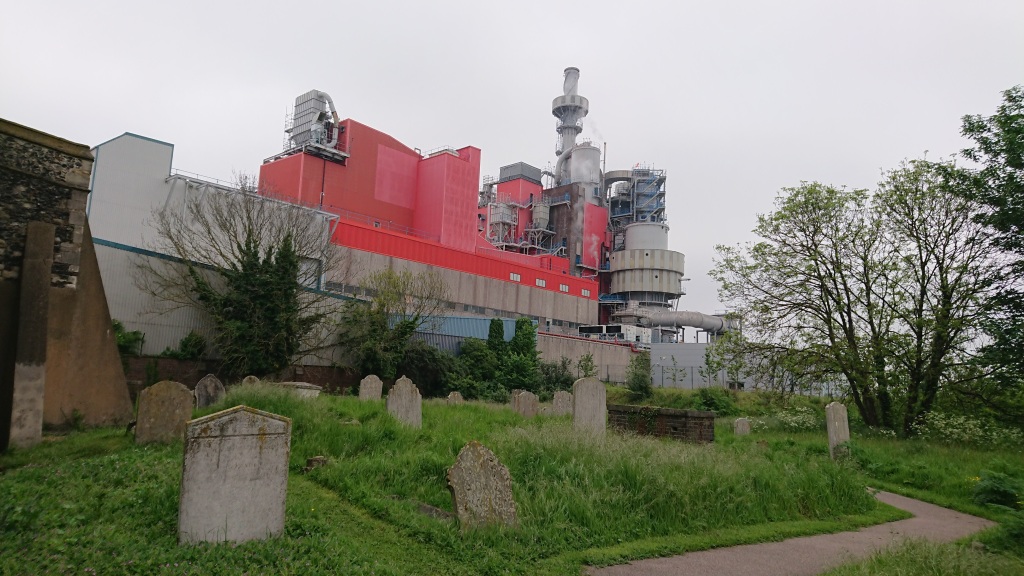I was on BBC Radio 3’s Free Thinking programme last night discussing the joys of Essex.
Here is a link: https://www.bbc.co.uk/programmes/m001lpky
It was a great panel – Tim Burrows, Simon Heffer and Elsa James, with Matthew Sweet. We had a glass of wine – chardonnay, naturally – and a fun chat.
Tim has just published a fantastic new book about the county, a mixture of social history, natural history and memoir: The Invention of Essex.
Anyway, in preparation I returned to a special place that my friend Laura Grace Ford first told me about: St Clements, West Thurrock.
Here’s a postcard:

It’s a Sunday morning, and I’m in the centre of a vast soapworks in the South Essex industrial hinterland. And I’m looking for a rather strange old building that doesn’t appear on many maps.
According to the anonymous chronicler behind A History of the County of Essex, Volume 8, ‘the choice of such an isolated and inconvenient site has not been explained’. You can say that again, as I drive along one private road after another towards the Thames, past one light industrial warehouse and logistics depot after another. Electricity pylons stalk the marshes. The air gently hums.
Eventually I pull up by an expanse of trees, the first I’ve seen of the colour green in quite a few miles. I’ve come to St Clements, West Thurrock. It’s a small church dating back to the 12th century, built of flint and ragstone rubble, with a peculiar little tower in the style of a Crusader’s turret. Wildflowers grow between the headstones. The air is heady with elderflower. A little bird dutifully chitters when I gingerly open the churchyard gate.
No-one is here. It sounds rather twee, except that it isn’t. Because flanked on all sides is the vast soapworks. To the left of me, six storeys high stands an inscrutable corrugated iron cube. To the right, what looks like a beached Royal Navy frigate, red paint splashed against silver, a webwork of chimneys and pipes brushing the overcast sky. Proctor and Gamble, making the country’s detergents and soaps, another form of personal cleansing taking place.
And then there’s the church, barely used today, built deep into the marshes, like a garrison in a conquered land.
St Clements West Thurrock points to two different images of Essex.
The first image is the rural idyll we associate with North Essex: John Constable country, sleepy churchyards in the gloaming, a bucolic landscape of tranquility and refuge, a place to make a home. And there is a lot of truth to this story, in the collective memory of Eastenders moving out from the slums towards the green space and clean air of Canvey, Clacton, Southend and beyond.
The second is more familiar: a crass panoply of dirty industries and debauched cockneys, of loose morals and cultural wasteland. Of Joey Essex and Essex Man. Historically, the Essex marshlands were associated with strange customs and malaria. The writer, spy and ineffectual businessman Daniel Defoe owned a brick factory for a time in nearby Tilbury. He recalled men who’d had dozens of wives, each prior taken by disease. Lives were shorter here, they always have been and still are. As a result, there’s a certain way of getting to the point here that has been historically confused with rudeness.
As I’ve cycled, walked and explored Essex over the years, I’ve always been struck at how these images and stories take on a life of their own. Thurrock somehow contains the two, beside its oil terminals, people’s palace shopping mall, palisades of suburbia and bankrupt Conservative administration. Essex, we know, is far richer and strange. But like the soapworks and St Clements on the marshes, it’s worth asking why Essex remains a kind of cultural shorthand for these conflicting points of entrance and exit: trash and tranquility, brashness and the bucolic, memory and all too easy forgetting. I love Essex all the more for it.

Leave a comment